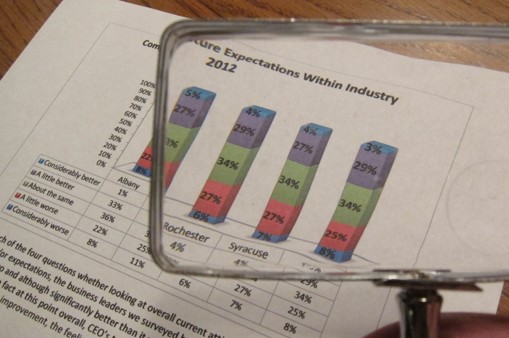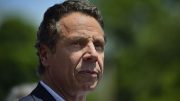Fourth Annual Survey of Upstate New York Business Leaders
1/11/11
Summary of Findings
Summary
The Fourth Annual First Niagara Survey of Upstate New York Business Leaders conducted by the Siena College Research Institute (SRI) shows that CEO confidence has significantly increased since last year. Today, nearly equal percentages of business leaders are positive about their current economic picture and optimistic towards the future as are those that continue to express negativity and pessimism. Growing numbers of CEO’s in New York are now prepared to not only say that they have survived the economic downturn, but now that they are back in and open for business. A majority of the most confident predict an uptick this year in profits and hiring. Unfortunately, an overwhelming percentage of the CEO’s of upstate New York lack confidence in the ability of New York’s political leaders to help in creating a business climate in which they can succeed. Still, growing percentages of CEO’s are more optimistic this year than last and far more hopeful than they were two years ago and that optimism indicates that they will concentrate on growing their businesses and serving their clients more so than simply trying to survive. Based on New York’s Upstate CEO’s, 2011 is likely to be a more robust economic year in the Empire State.
Business Leader Confidence
The overall Index of Upstate New York Business Leaders reached 98.4 up 12 points from last year and 59.4 points from two years ago. The Index is now nearly at the 100 mark at which equal percentages of CEO’s are both optimistic and pessimistic about economic conditions in their industry and across the state. The current index component that assesses business conditions today as compared to six months earlier is now 93.8 up 15.7 from last year and 62.7 from two years ago. The future component that measures expectations for the coming year is 103.1 up 8.3 from a year ago and 56.2 from two years ago. Thirty-five percent of CEO’s of private, for-profit companies with sales between $5 million and $150 million in the Capital Region, Buffalo, Rochester and Syracuse now expect better economic conditions in New York next year. Only 33 percent compared to 41 percent last year anticipate worsening conditions.
This survey reports data from 645 corporate leaders drawn from Service (29%), Manufacturing (18%), Engineering/Construction (15%), Retail (13%), Wholesale/Distribution (13%), Financial (8%) and Food/Beverage (3%). If equal numbers of CEO’s had positive and negative perceptions of and expectations for the general economy as well as for the condition of and future for their industry, the overall index would be 100. Financial (113.4), Manufacturing (106.7) and Retail (101.5) have the highest overall index readings but every sector improved from last year. Of the four upstate MSA’s (metropolitan statistical areas), the index is greatest in Rochester (109.1 overall, 103.7 current, 114.6 future) followed by Syracuse (101, 95.9, 106.2), Buffalo (93.4, 90.9, 96) and the Capital Region, the only area that saw a decline (90.4, 83.9, 96.9).
Thirty-four percent, down from 47 percent, of CEO’s now say that business conditions have worsened in New York over the last half of 2010 while 29 percent feel as though the economy has already improved. Despite the plurality of worsening current perception, today’s assessment is far better than two years ago when only 2 percent thought things had improved as 2008 ended against 83 percent that saw worsening conditions.
Based upon CEO’s responses to the four key index questions, the study identifies three distinct groups of business leaders today in Upstate New York. Thirty-five percent of CEO’s, up from 30 percent a year ago and only 14 percent two years ago, report being able to currently thrive and are strongly optimistic about the future. Thirty-nine percent of CEO’s (up from 36% in 2009 and 27% in 2008) acknowledge being seriously impacted by recent economic conditions, but they tend to feel as though things are beginning to improve. The remaining 26 percent (down from 34% a year ago and 58% in 2008) have been very seriously affected by the economy and believe that economic conditions may continue to worsen in both New York and their industry before getting better.
Revenues, Profits and Labor Force
Expectations for revenues and profits through 2011 increased among CEO’s this year, and those that fear continuing revenue declines have significantly lessened. While CEO’s plans to acquire new fixed assets are virtually unchanged from last year, more than twice as many, 27 percent plan to enlarge their workforce this year as compared to 12 percent (down from 17%) planning layoffs.
Forty-five percent of CEO’s anticipate increasing revenues during 2011 as compared to 35 percent last year, and only 23 percent expect less revenue this year as compared to 31 percent having that expectation last year. Thirty-two percent anticipate increasing profitability this year (up from 30%) while a nearly equal number, 31 percent (down from 38%), continue to expect declines.
Despite increasing confidence and growing expectations of higher revenues and profits, fixed asset acquisition plans remain at just over 50 percent. Of those that do anticipate asset acquisitions, 60 percent plan to use internally generated funds as opposed to either borrowing from a financial institution (28%) or private equity (7%).
Twenty-seven percent of business leaders expect to at least moderately increase their workforce in 2011 up from 22 percent a year ago. While 61 percent intend to have their workforce remain the same, 12 percent, down from 17 percent, plan on decreasing their labor force. Three years ago at the time when most agree the recession was just beginning, 36 percent of CEO’s said they planned to increase their workforce as compared to only 6 percent anticipating reductions.
Concentrations, Challenges and Attitudes towards Government
Today a growing number of CEO’s are becoming more focused on growing the market for their products and services. Market growth as a top profit enhancement strategy is up from 28 percent two years ago to 42 percent today. Still, 37 percent continue to put cost reductions first with optimistic companies tending to target growing sales while the more pessimistic companies still primarily look to cost cuts as a business strategy.
Overwhelmingly, the number one concern among upstate New York business leaders is adverse economic conditions (28%) followed by governmental regulation (18%), and taxation (16%). Health care was mentioned by 79 percent but only 12 percent see it as the top concern.
Forty-five percent of CEO’s call on the new Governor and Legislature to cut spending as their top focus. Eighty-six percent say the government of New York is doing a poor job of creating a business climate in which their company can succeed and 93 percent are either not very or not at all confident in the ability of the government to improve the business climate in New York. While many CEO’s are more confident in their business prospects, it is at this point, in spite of rather than because of New York’s political situation.
New York Crosstabs





